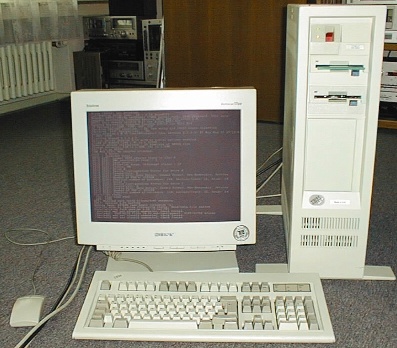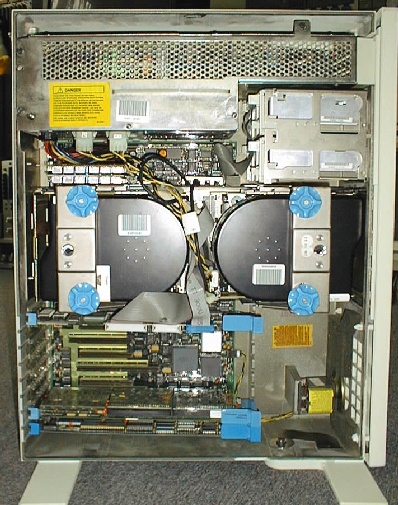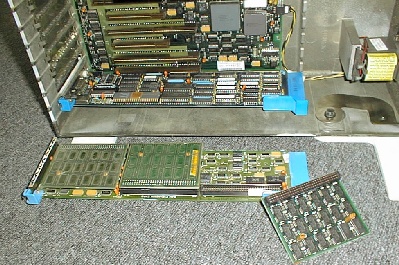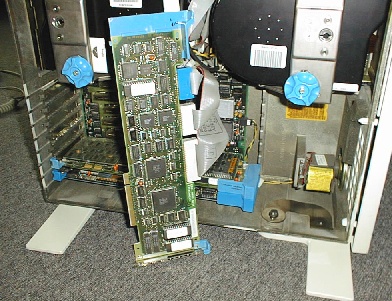
Click here or click onto the photo for a full size version of this picture.
Same machine, but different hard disk - The ST506 controller of the original 8580-041 was quickly replaced with an ESDI controller and appropriate disks. Compared to ST-506, ESDI had the option for faster data rates: While ST-506 is fixed at 5 or 7.5 Mbits/s, on an ESDI interface, the hard drive dictates the data rate. Typical EDSI disks used by IBM at that time used 10 MBits/s and had therefore a data rate roughly double as high as the old MFM disks.

Click here or click onto the photo for
a full size version of this picture.
You have to take a close look at the controller and hard drives to distinguish ESDI and MFM. The cabling is the same, and at least as long as there are IBM disks in the machine, even the disk drives look the same (and give the machine the same horrendous weight - there's a reason for the massive handle...). Originally, IBM offered 70M drives (that's what the designation comes from, but 115M drives were introduced not much later. This machine has two of them, allowing to run a minimal Linux distribution. It's however not much fun to use it, for two reasons:
- The Linux driver for the PS/2 ESDI controller isn't very well optimized; since the ESDI controller has no track buffer and the driver passes the 1K requests from ext2 as-is, the effective data rate is about 57Kbytes/s, almost an order of magnitude slower than it could be. I have to do something about this RSN...
- The 16 MHz main board, the very first Model 80 board, seems to have a couple of design flaws resulting in randomly occuring NMIs and program crashes. Later board revisions with at least 20MHz CPUs do not exhibit this problem.

Click here or click onto the photo for
a full size version of this picture.
The memory modules for the RAM expansion card in this machine are as unique as the Model 80's main board memory modules: the connector is the same, but it's rotated by 90 degrees so that the modules lie flat on the card. Each module adds 2 MBytes, so the card maxes out a 6 MBytes. Later RAM cards used the more familiar 72-pin SIMMs.
One might expect that the RAM on the card is slower than the planar memory. At least for the 16 MHz version, this is not true. The 32-bit-slots have a few more contacts making up the 'matched memory expansion'. When the card is accessed, it sends a signal back to then planar via this extension, which instructs the planar to switch from the standard MCA bus cycle to to the timing of a planar memory access. The gain is however limited, since two clocks plus one wait state at 16 MHz aren't notably faster than two clocks at 10 MHz without a wait state. IBM therefore removed this feature in later boards: the contacts are still there, but they aren't connected to anything, so the card doesn't get an acknowledgement.

Click here or click onto the photo for
a full size version of this picture.
The most notable difference of the ESDI controller from its ST-506 predecessor is the on-board BIOS, so it runs in also in first-generation PS/2s whose BIOS doesn't know anything about ESDI.
- Processor:
- Intel i386DX @ 16MHz
- Coprocessor:
- Intel i387DX @ 16 MHz
- Cache:
- none
- Memory:
- 10 Mbytes (options range from 1M to 4M)
- Bus:
- 8 MCA slots (3x32 bit, 5x16 bit)
- Interfaces (onboard):
-
- Mouse, Keyboard
- 1x Serial
- 1 x Parallel
- Floppy (1.44M), allows attachment of up to 2 drives
- VGA
- Add-on cards:
-
- SKnet Junior MC2 Ethernet Adapter
- IBM ESDI Hard Disk Controller
- IBM Enhanced Memory Expansion
- IBM 2-14MB 386 Memory Epansion Board
- Operating System(s):
-
- Linux 2.0 (Slackware-based)
- Useful Links: